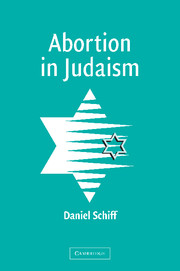Book contents
- Frontmatter
- Contents
- Preface
- 1 The conundrum takes shape: foundational verses
- 2 Evaluating life: rabbinic perspectives on fetal standing
- 3 Divining a prohibition: the positions of the Rishonim and Acharonim
- 4 No clear consensus: the sages of a rising modernity
- 5 The struggle returns: Jewish views begin to take form
- 6 Confronting a new reality: legislation for a Jewish state
- 7 A halakhic challenge: discerning Jewish abortion principles
- Glossary
- Bibliography
- Index
3 - Divining a prohibition: the positions of the Rishonim and Acharonim
Published online by Cambridge University Press: 09 November 2009
- Frontmatter
- Contents
- Preface
- 1 The conundrum takes shape: foundational verses
- 2 Evaluating life: rabbinic perspectives on fetal standing
- 3 Divining a prohibition: the positions of the Rishonim and Acharonim
- 4 No clear consensus: the sages of a rising modernity
- 5 The struggle returns: Jewish views begin to take form
- 6 Confronting a new reality: legislation for a Jewish state
- 7 A halakhic challenge: discerning Jewish abortion principles
- Glossary
- Bibliography
- Index
Summary
Five hundred years had passed since the close of the Talmud. The locus of Jewish legal thought had shifted from Eretz Yisrael, Sura, and Pumbedita to the lands of Europe. The period of the Geonim (heads of the Babylonian academies) had faded into history. Yet, in a manner characteristic of Jewish legal authorities, Rashi (1040–1105), the Talmud's preeminent commentator, wrote as if the passage of time and the changing cultural geography had all meant nothing. In large measure, Rashi's position reiterated the rabbinic view of fetal status, albeit with one significant elaboration. In the case of a woman undergoing treacherous labor, Rashi's prescription and rationale could hardly have been clearer or more reminiscent:
It is removed limb by limb, for, as long as the being did not come out into the world, it is not a nefesh and it is permitted to kill it and to save its mother. But, if the head has emerged, it may not be harmed, because it is considered as fully born, and one may not take the life of one nefesh in favor of another.
Just as his rabbinic forebears were, Rashi was plainly in no doubt that when the woman's life was threatened, the interests of the unborn were subordinate to those of its mother. Rashi's rendering, however, takes the Mishnah one fundamental step beyond what had previously been articulated.
- Type
- Chapter
- Information
- Abortion in Judaism , pp. 58 - 94Publisher: Cambridge University PressPrint publication year: 2002



